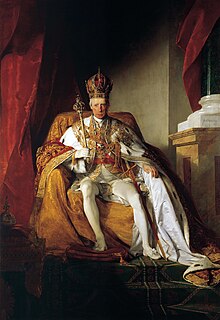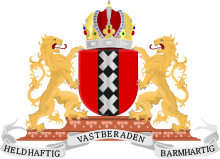Austrian imperial crown

As Austrian imperial crown of the proclamation was in Empire of Austria in 1804, the Rudolf crown , the private crown of Emperor Rudolf II. Determined. Even after the Austro-Hungarian Compromise (1867) it remained the imperial crown of the Emperor of Austria until 1918 - then only for the cisleithan part of the empire.
Since the imperial regalia of the Holy Roman Empire , in particular the imperial crown , were kept by the city of Nuremberg and only issued on the occasion of a coronation , some rulers had private crowns made for themselves, under which they appeared on official occasions (e.g. at the Reichstag ). The oldest illustration of such a private crown is a copper engraving by Emperor Maximilian I by Albrecht Dürer ; it is believed that this depiction influenced the appearance of the Rudolf crown.
Rudolf II's crown was made in Prague in 1602 and was made by Jan Vermeyen , one of the most important goldsmiths of his time, who was called from Antwerp for it. It consists of three parts: a crown ring , a crown bow and a miter . It follows the type of miter crowns that are reminiscent of bishop's hats.
It was never used for an actual coronation.
Crown circlet
The shape of the crown circlet already forms a crown - the miter and the bow are, so to speak, turned inside. It thus symbolizes the royal dignity. Eight lilies protrude from it, which are probably inspired by the Bohemian Wenceslas crown - they are also occasionally associated with the lilies of the Valois (to which the Habsburgs are related through the House of Burgundy ). The 8 is taken from the imperial crown, the ring of which consists of 8 plates. The coronet bears 8 diamonds, which symbolize Christ, whom the emperor represents on earth. The 8 stands as a doubled 4 (it is the number of the material, created world - compare 4 cardinal points, 4 seasons, and so on) for the perfect. Diamonds were chosen because the ancient Greek word adámas, from which the term diamond is derived, means "indomitable".
Red spinels , zircons and simple pearls are worked into the ring, some of the zircons are table cut (so that they are flattened at the front). The cutting of precious stones was a relatively new technique back then.
The ruby over the forehead was probably used on the order of Rudolf II to express that the wearer of the crown is filled with the fire of the Holy Spirit and thus with wisdom, also because the red color in the church marks Pentecost (Descent of the Holy Spirit). The red color can also be found in the small lilies of the coronet. There the red stones are arranged like obelisks , which again represents a symbol of wisdom.
Miter
The miter symbolizes the divine right and also the spiritual rank of the emperor: he was also symbolically ordained a deacon at his coronation . It is rotated by 90 °, the surfaces point to the side, so that the temple extends from the front like the imperial crown. The miter is made of gold with strips of enamel around the edge depicting birds and plants. The miter is divided into four parts, which show the four dignities of Rudolf II: first, the kneeling reception of the imperial crown in Regensburg ( Emperor of the Holy Roman Empire ), second, the ride on the coronation hill in Pressburg ( King of Hungary ), third, the coronation procession through Prague (King of Bohemia ) and fourthly, an allegory of the victory over the Turks , which Rudolf did not succeed in in reality.
Picture gallery of the miter
Crown bracket
The crown bow, which is reminiscent of the Roman-German imperial crown , has a blue sapphire, since according to Revelation (21:19) the foundation stones of the heavenly Jerusalem will be made of sapphires. Emperor Rudolf II, who was certainly familiar with the old stone allegories, probably wanted to use the position of the sapphire above the cross to convey to his devout subjects that divine glory, i.e. heaven, can be reached via the path of the cross.
Scepter and orb
The crown also includes a scepter and an orb , which were commissioned by Rudolf's brother and successor Matthias in 1612 . They come from Andreas Ochsenbruck . The design is based heavily on the crown, in particular the enamel work is clearly copied here. A special feature of the scepter is that it consists partly of ainkhürn (a narwhal's tooth , which was mistaken for the horn of a unicorn ). Scepter and imperial orb were used again and again before the proclamation of the Austrian Empire, partly as Bohemian royal insignia, partly for hereditary homage in the Archduchy of Austria .
The crown, scepter and orb are now in the secular treasury of the Hofburg in Vienna .
The crown in the coat of arms
From 1804 to 1867 the Rudolf crown hovers over the Austrian double-headed eagle , from 1867 to 1918 right over Austria ( the kingdoms and states represented in the Reichsrat or Cisleithanien , from 1915 Austrian states ).
Small coat of arms Austrian Empire 1815
The double-headed eagle holds the imperial sword and scepter in its claws, in the breastplate Habsburg-Lorraine with the Order of the Golden Fleece .Middle common coat of arms Austria-Hungary
The Austrian eagle with the most important crown lands occupiedSmall joint coat of arms Austria-Hungary 1915
Austria under the Rudolf crown, heraldic left Transleithanien under the Stephanskrone , in the middle Habsburg-Lothringen under the Habsburg crown .Small coat of arms Austrian countries 1915
The shield for Austria.
The crown is on the coat of arms of Amsterdam , a gift from Emperor Maximilian I as a thank you to the city. Various buildings are adorned with the crown, such as the tower of the Westerkerk and the lanterns of the Blauwbrug .
Three-dimensional Austrian imperial crown, Blauwbrug , Amsterdam
The right to run the crown was granted to many purveyors to the court ; the Royal Brewery Krušovice uses the crown z. B. as a logo today.
literature
- Secular and spiritual treasury. Image guide. Kunsthistorisches Museum, Vienna 1987, ISBN 3-7017-0499-6 .
- Hermann Fillitz : The treasury in Vienna: symbols of occidental empire. Vienna 1986, ISBN 3-7017-0443-0 .
- Hermann Fillitz: The Austrian Imperial Crown and the Insignia of the Austrian Empire. Vienna 1973, ISBN 3-7008-0015-0 .















